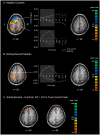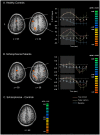An event-related FMRI study of phonological verbal working memory in schizophrenia
- PMID: 20725639
- PMCID: PMC2921150
- DOI: 10.1371/journal.pone.0012068
An event-related FMRI study of phonological verbal working memory in schizophrenia
Abstract
Background: While much is known about the role of prefrontal cortex (PFC) in working memory (WM) deficits of schizophrenia, the nature of the relationship between cognitive components of WM and brain activation patterns remains unclear. We aimed to elucidate the neural correlates of the maintenance component of verbal WM by examining correct and error trials with event-related fMRI.
Methodology/findings: Twelve schizophrenia patients (SZ) and thirteen healthy control participants (CO) performed a phonological delayed-matching-to-sample-task in which a memory set of three nonsense words was presented, followed by a 6-seconds delay after which a probe nonsense word appeared. Participants decided whether the probe matched one of the targets, and rated the confidence of their decision. Blood-oxygen-level-dependent (BOLD) activity during WM maintenance was analyzed in relation to performance (correct/error) and confidence ratings. Frontal and parietal regions exhibited increased activation on correct trials for both groups. Correct and error trials were further segregated into true memory, false memory, guess, and true error trials. True memory trials were associated with increased bilateral activation of frontal and parietal regions in both groups but only CO showed deactivation in PFC. There was very little maintenance-related cortical activity during guess trials. False memory was associated with increased left frontal and parietal activation in both groups.
Conclusion: These findings suggest that a wider network of frontal and parietal regions support WM maintenance in correct trials compared with error trials in both groups. Furthermore, a more extensive and dynamic pattern of recruitment of the frontal and parietal networks for true memory was observed in healthy controls compared with schizophrenia patients. These results underscore the value of parsing the sources of memory errors in fMRI studies because of the non-linear nature of the brain-behavior relationship, and suggest that group comparisons need to be interpreted in more specific behavioral contexts.
Conflict of interest statement
Figures



Similar articles
-
Origins of spatial working memory deficits in schizophrenia: an event-related FMRI and near-infrared spectroscopy study.PLoS One. 2008 Mar 12;3(3):e1760. doi: 10.1371/journal.pone.0001760. PLoS One. 2008. PMID: 18335036 Free PMC article.
-
Disturbed functional connectivity within brain networks subserving domain-specific subcomponents of working memory in schizophrenia: relation to performance and clinical symptoms.J Psychiatr Res. 2010 Apr;44(6):364-72. doi: 10.1016/j.jpsychires.2009.09.003. Epub 2009 Oct 17. J Psychiatr Res. 2010. PMID: 19837416
-
Posterior Parietal Cortex Dysfunction Is Central to Working Memory Storage and Broad Cognitive Deficits in Schizophrenia.J Neurosci. 2018 Sep 26;38(39):8378-8387. doi: 10.1523/JNEUROSCI.0913-18.2018. Epub 2018 Aug 13. J Neurosci. 2018. PMID: 30104335 Free PMC article.
-
Working memory deficit in schizophrenia: a systematic review and meta-analysis of fMRI studies examining frontal and parietal brain activity.Folia Neuropathol. 2024;62(2):136-146. doi: 10.5114/fn.2023.132329. Folia Neuropathol. 2024. PMID: 38174682
-
The neuroplastic effect of working memory training in healthy volunteers and patients with schizophrenia: Implications for cognitive rehabilitation.Neuropsychologia. 2015 Aug;75:149-62. doi: 10.1016/j.neuropsychologia.2015.05.029. Epub 2015 May 29. Neuropsychologia. 2015. PMID: 26032579 Review.
Cited by
-
WORKING MEMORY IMPAIRMENT AS AN ENDOPHENOTYPIC MARKER OF A SCHIZOPHRENIA DIATHESIS.Schizophr Res Cogn. 2014 Sep 1;1(3):127-136. doi: 10.1016/j.scog.2014.09.005. Schizophr Res Cogn. 2014. PMID: 25414816 Free PMC article.
-
Working memory impairment in probands with schizoaffective disorder and first degree relatives of schizophrenia probands extend beyond deficits predicted by generalized neuropsychological impairment.Schizophr Res. 2015 Aug;166(1-3):310-5. doi: 10.1016/j.schres.2015.05.018. Epub 2015 May 23. Schizophr Res. 2015. PMID: 26008884 Free PMC article.
-
Impact of load-related neural processes on feature binding in visuospatial working memory.PLoS One. 2011;6(8):e23960. doi: 10.1371/journal.pone.0023960. Epub 2011 Aug 24. PLoS One. 2011. PMID: 21887352 Free PMC article.
-
Load-sensitive impairment of working memory for biological motion in schizophrenia.PLoS One. 2017 Oct 13;12(10):e0186498. doi: 10.1371/journal.pone.0186498. eCollection 2017. PLoS One. 2017. PMID: 29028821 Free PMC article.
-
Modelling neural correlates of working memory: a coordinate-based meta-analysis.Neuroimage. 2012 Mar;60(1):830-46. doi: 10.1016/j.neuroimage.2011.11.050. Epub 2011 Dec 1. Neuroimage. 2012. PMID: 22178808 Free PMC article.
References
-
- Park S, Lee J. Spatial working memory function in schizophrenia. In: Lenzenweger MF, Hooley JM, editors. Principles of experimental psychopathology. Washington, DC: APA; 2002. pp. 83–106.
-
- Baddeley AD. New York: Oxford University Press; 1986. Working Memory.
-
- Goldman-Rakic PS. Prefrontal cortical dysfunction in schizophrenia: the relevance of working memory. In: Carroll B, editor. Psychopathology and the Brain. Raven Press: New York; 1991. pp. 1–22.
-
- Park S, Püschel J, Sauter B, Rentsch M, Hell D. Spatial working memory deficits and clinical symptoms in schizophrenia; A 4-month follow-up study. Biol Psychiatry. 1999;46:392–400. - PubMed
-
- Lee J, Park S. Working memory abnormalities in schizophrenia: A meta-analysis. J Abnorm Psychol. 2005;114:599–611. - PubMed
Publication types
MeSH terms
Grants and funding
LinkOut - more resources
Full Text Sources
Medical
Miscellaneous

